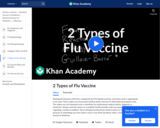
Distinguish between LAIV (live, weakened) and TIV (dead) vaccines, and when each is appropriate to be used.
- Subject:
- Disease
- Health and Medical Science
- Material Type:
- Lesson
- Provider:
- Khan Academy
- Author:
- Khan Academy
- Date Added:
- 09/22/2013
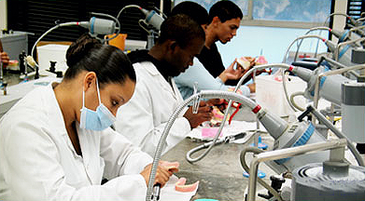

Distinguish between LAIV (live, weakened) and TIV (dead) vaccines, and when each is appropriate to be used.
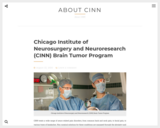
This Web site provides a series of 12 online modules that address pain in the following areas: pathophysiology, assessment, pain management options, older adults, pediatrics, persistent pain, cancer pain, neuropathic pain, pharmacotherapy, and end-of-life care.
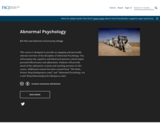
This course is designed to provide an engaging and personally relevant overview of the discipline of Abnormal Psychology. You will examine the cognitive and behavioral patterns which impair personal effectiveness and adjustment. Students will provide much of the substantive content and teaching presence in this course. Additional content has been curated from "The Noba Project (http://nobaproject.com/)" and "Abnormal Psychology: An e-text! (http://abnormalpsych.wikispaces.com/).

What causes addiction? Easy, right? Drugs cause addiction. But maybe it is not that simple. The video "Addiction" is a resource included in the Disease topic made available from the Kurzgesagt open educational resource series.
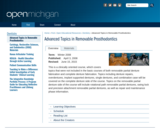
This is a clinically oriented course, which covers topics that were not included in the basic courses of both removable partial denture fabrication and complete denture fabrication. Topics including denture repairs, overdentures, implant supported dentures, single dentures, and combination case will be covered on the complete denture side of the course. Topics on the removable partial denture side of the course will include rotational path removable partial dentures, swing lock and precision attachment removable partial dentures, as well as repair and maintenance phase information.
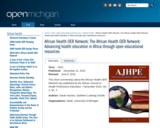
This short commentary about the African Health OER Network was published by the African Journal of Health Professions Education, December 2010, Vol. 2, No. 2.

This presentation aims to increase the students’ knowledge about environmental epidemiology, by introducing different study designs used to study health effects of exposure to outdoor air pollution. All study designs are illustrated by examples, starting with the Great Smog (Killer Fog) of London in 1952, one of the landmarks in environmental epidemiology.

Nearly one third of the world’s population are exposed to high levels of indoor air pollution from the household’s use of solid fuel. The fuel is mainly biomass burning under poor combustion conditions
in open fires or primitive stoves and with low ventilation. This costs more than 4 million lives every year and enormous suffering in particular among women and children.

What is air pollution? What is it in the air that is harmful? This lecture focuses on air pollution, where it occur, and how it spread.

In this presentation, we will describe the global levels and trends in major air pollutants and related health burden. Air pollution is an important global risk factor for disease. People who live in more polluted areas develop more often chronic and infectious disease and die prematurely as compared to people living in areas with low air pollution.

In large part of the World, people spend more than 90 percent of the time in indoor environments, where air quality is important for health. The environment outside the building, what goes on inside the building and the exchange of air pollutants affects the indoor air. Tight buildings can reduce energy consumption and entry of outdoor air pollutants, but unless ventilation is right indoor air pollutants from combustion processes, dampness, microbes, the dwellers bio effluents,
appliances, care and cleaning products, clothing, furniture, building materials, the underground and many other sources will build up indoors causing important health effects.

In this presentation, we will discuss how we can know whether one individual is more susceptible to harmful effect of air pollution than others are. Everyone is exposed, but some groups may be more susceptible to the harmful effect of air pollution than others may.

In this lecture, we will describe the mechanisms by which air pollution causes pulmonary health effects in the human population. The pulmonary health effects include exacerbation of asthma and chronic obstructive pulmonary diseases (COPD), increased risk of lower
respiratory tracts infections and lung cancer.

In this presentation, we will describe the mechanisms by which air pollution causes health effects in other parts of the body than the lungs. In continuation of this, we will discuss the important mechanisms of extra pulmonary health effect.

There is a long way before the whole world complies with the WHO guidelines for air quality, but the enormous burden of disease from outdoor air pollution forces us to increase action to come as far as possible. In continuation of this, we will discuss what we can do about air pollution at global, international, national, city and individual levels. Most of the actions to reduce air pollution also mitigates climate change and/or promote health in other ways – so there are many win-win and
win-win-win situations

Provides information about current treatment and the latest research in the treatment of heart disease in this country. Links to many additional sites.
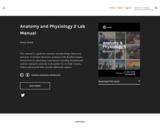
Anatomy and Physiology 2 Laboratory Manual is a guide for anatomy and physiology laboratory exercises. It includes dissection guidance with detailed images; instructions for physiology experiments including foundational content; and gross anatomy study guides for six body systems. Videos and tutorial links provide additional support. including studies in the following areas:
Endocrine
Blood
Cardiovascular
Respiratory
Digestive
Urinary
Reproductive
Fetal Pig Dissection
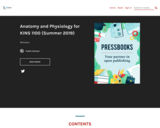
This open textbook is adapted from OpenStax’s Anatomy and Physiology for Carmen Bott’s KINS 1100 (Biodynamics of Physical Activity) class at Langara College. Sections have been omitted from the original textbook to reflect the KINS 1100 curriculum, but the content is otherwise unchanged.

The primary learning objective of this textbook is to introduce the reader to the fundamental statistical methods and basic analytical procedures associated with processing data in regard to healthcare research. It is intended that by working through the applications and practice problems, readers should be able to understand and apply some of the methods for developing, implementing, and applying healthcare statistic principles in research.
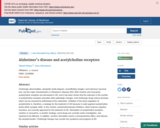
The resource , ''Article AD ACh (pdf)'' included in "Lesson 3 Neurophysiology and Neuropharmacology" is a part of "Unit 01 Intro to neuroscience" included in Health & Life Sciences HLS - Course 4.